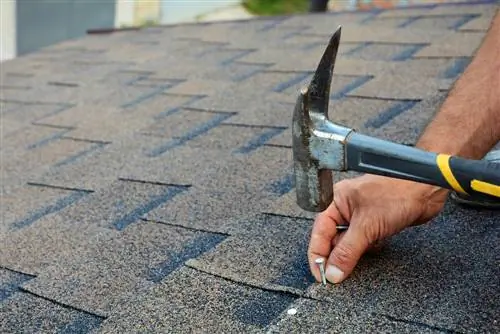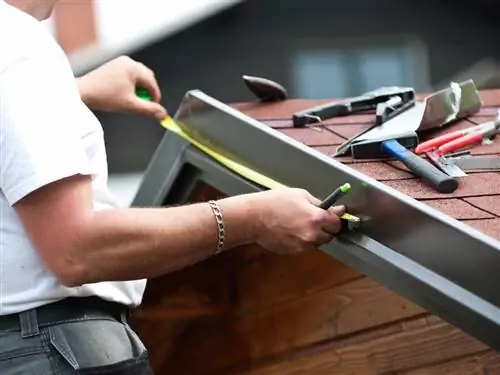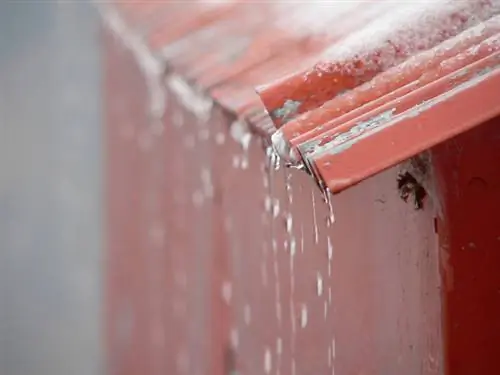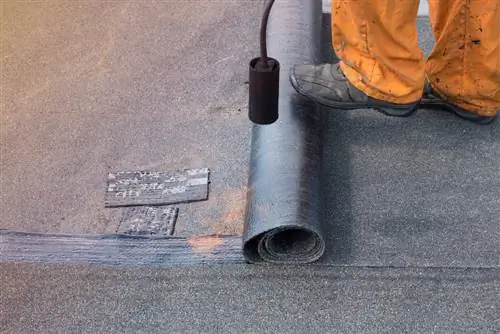- Author admin [email protected].
- Public 2023-12-16 16:46.
- Last modified 2025-01-23 11:21.
Even if roofing felt or bitumen shingles are quite robust roofing materials, at some point they get old and water penetrates into the house. The damage should then be repaired as quickly as possible so that mold does not form inside. The repair is not difficult and can be done easily by even less experienced craftsmen.
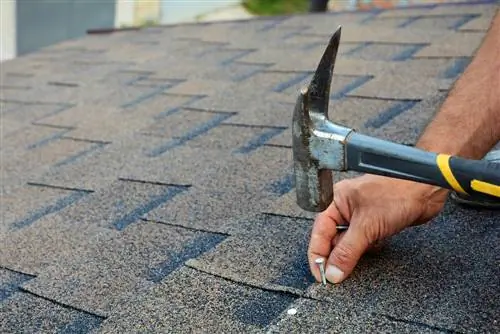
How can I seal the roof of a garden house?
To seal a garden house roof, first repair minor damage with roofing paint or cold glue. If there is major damage or the roofing membrane is loose, you will have to re-lay the roofing felt. Pay attention to transitions to the gutter or wall and use suitable materials for sealing.
Where does the water get in?
Damaged areas in large puddles do not always appear on the ground. You can recognize smaller defects by discoloration of the wood or moisture that collects beneath the ceiling. So that you don't miss them, we recommend the following procedure:
- Empty the house completely for the visual inspection.
- Take a powerful flashlight (€13.00 on Amazon) and check the inside thoroughly.
How extensive is the damage?
- If only a little water gets in, the repair is usually easy and can be done without a lot of time.
- Have entire roofing sheets come loose? Then the roofing felt has to be re-laid.
- Have you found several places where water is getting in, but the roofing felt is intact? Then you have to remove the roof covering and lay new welding membranes underneath.
- The transitions to the gutters or the wall are leaking? Here you cannot seal with roofing felt, but have to take other measures.
Repair minor damage
Here it is usually enough to repair the leaks with roof paint or cold glue. The bitumen products used for this work adhere permanently to gloves, clothing and tools, so only use used tools that you then dispose of.
- The roof must be dry. That's why beautiful spring, summer or autumn days are best.
- Sweep the roof well so that the sealing materials adhere reliably.
- Paint roof paint onto the damaged areas and allow to dry thoroughly.
- Alternatively, stick roofing felt over the areas with cold glue.
- Check for leaks by spraying plenty of water onto the roof.
Re-laying roofing felt
Depending on whether several areas of the roof have become leaky, it may be necessary to lay new roofing felt over the entire roof. Sometimes it is also possible to replace just a single track.
- When re-covering, always start at the bottom and overlap the first strip by a few centimeters.
- Nail the track.
- Let the second strip lap about ten centimeters over the one underneath and also secure it.
- Be careful not to step on the material that has already been laid so as not to damage it.
Tip
For a longer lifespan, we recommend applying a protective coat of paint to the roofing felt approximately every three years. The cold-paintable products are available in different colors, so that the roof surface can be visually adapted to the design of the arbor.

